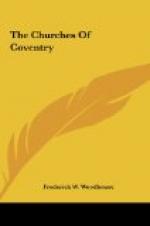Here lyes an old toss’d Tennis Ball
Was racketted, from spring to fall,
With so much heat and so much hast,
Time’s arm for shame grew tyred
at last.
Four kings in camps he truly served.
And from his loyalty ne’er swerved,
Father ruin’d and son slighted,
And from the Crown ne’er requited.
Loss of estate, relations, blood,
Was too well known, but did no good;
With long Campaigns and paines oth’
gout
He you’d no longer hold it out.
Always a restless life he led,
Never at quiet till quite dead.
He marry’d in his later days,
One who exceeds the common praise
But wanting breath still to make known
Her true affection and his own,
Death kindly came, all wants supplied
By giving rest—which life deny’d.
The other brass, of 1609, has a portrait of Ann Sewell in Jacobean costume, kneeling, with an epitaph in which she is described as “a worthy stirrer up of others to all holy virtues.”
A doorway leads to a priest’s chamber over the porch, sometimes incorrectly spoken of as the Cappers’ Chapel. It is still used for the annual meeting of the Company, but is inaccessible to the public.
The next chapel eastwards is St. Thomas’, belonging until 1629 to the Cappers’ and Feltmakers’ Company. In 1531 they were associated in its maintenance with the Woollen Cardmakers who had founded it in 1467 and had after declined in importance. Leland, as we have seen records also the decay of the Cappers’ industry. A large eighteenth-century monument conceals the original doorway from the porch. The eastern part of the south aisle as far as the screen formed another chapel as the dilapidated piscina in the south wall shows. The organ is now placed in the first bay of the chancel aisle, the whole aisle having once formed the Mercers’ Chapel.
[Illustration: THE SWILLINGTON TOMB.]
Where the altar once stood are now steps descending to the sacristies. On the right of the window is the statue of St. Michael brought hither from the tower. The finely carved corbel on which it stands was discovered among rubbish in the recess below. Three altar tombs now stand against the south wall. The eastern has the recumbent effigies of Elizabeth Swillington and her two husbands. The inscription (translated) runs: “Pray for the soul of Elizabeth Swillington, widow, late the wife of Ralph Swillington, Attorney General of our Lord King Henry VIII, Recorder of the city of Coventry, formerly the wife of Thomas Essex Esq: which said Elizabeth died A.D. 15...” She died after 1543. The side and ends have arcaded panelling containing shields of arms. At the west end is a realistic representation of the Five Wounds. The effigy of Thomas Essex is in armour, that of the Recorder in official robe and chain. The head of each rests on a helmet, and the lady wears the “pedimental” headdress of Tudor fashion. The arcading is purely Renaissance in detail though the general treatment is mediaeval. The figures are in dignified repose, wholly free from the later affectations of the Elizabethan school yet evidently individual portraits. The second tomb dates from 1640. The top is far too heavy for the little Ionic pilasters below.




